I started the Instruments class at the A&P school last night. This one should be every bit as interesting as the sheet metal structures class I took in the spring. It's two five-hour classes a week, same as list time, so it's definitely going to have a severe impact on my free time, but it looks like it will make up for that by being quite interesting.
Last night was more or less review for most of the class given that four of the five students are either licensed pilots or very nearly so, and the 5th guy has a background in naval aviation. The program is a part 147 school, which when boiled down means the curriculum is very structured, and despite the fact that every student in the room knows what an altimeter or airspeed indicator does, we have to go through the motions of assuming no one in the room has ever seen either of them before. That part goes quickly, though, as the expectation that there will be clarifying questions from the students is virtually nil. As with all of these classes I've had so far, though, no matter how familiar the subject matter is, there is always something more to learn. In last night's discussion of altimeters, airspeed indicators, and VSIs there were more than a few very subtle details provided that went beyond what we were taught as fledgling pilots. A five hour lecture is a looonnnnngggg lecture, so the periodic emergence of a nugget of new info was extremely welcome.
As the class progresses, it will get even more interesting because we will have the opportunity to do some lab work. Next Monday, for example, we've been instructed to bring a flashlight, side cutters, and a flat file. The flashlight will be used as we tour the flight deck of the old FedEx Boeing 727 that was recently donated to the school. The cutters and file will be used to craft a brass screwdriver that we will then use to swing magnetic compasses. As I found in the sheet metal class, the A&P curriculum eerily shadows my real-world needs: since I moved the mag compass to a different spot in my panel to make room for the Anywhere Map PDA, it has indicated quite a few degrees in error. I swung the compass in the Tampico once, but I did it without the benefit of any formal training. I'll soon know what I did right and what I may have done wrong back then, and will quickly apply that knowledge to my current problem.
It's a new teacher (to me, anyway) this time around, and he has an interesting teaching style. Rather than write a list of flight instruments on the board to discuss, he has the class see how complete of a list we can generate. Now and then he'll throw in a little factoid and challenge us to say why this or that is the case. For example, last night as he was talking about altimeters he threw out the fact that they are usually mounted using brass bolts. "Why is that?" Well, I took a guess at it. Mind you, I know that brass is used to mount things like the mag compass to avoid magnetic interference that could affect the accuracy of the compass. But he was asking about the altimeter, and we had just talked about its inherent delicacy. I offered up the opinion that a brass mounting bolt would be softer than the metal of the altimeter's case and would thus not provide sufficient torque to warp the case. BZZZZTTTT - wrong answer! It was still the magnetic interference issue. Oh well, sez I, that's what I get for not taking the obvious answer. Every class needs a smart ass, and I have long played that role. And of course, as we all know there are no smart donkeys in the circus because nobody likes a smart ass.
We also spent a lot of time talking about the pitot-static system and perusing the FAA regs that govern inspections and currency of same. Because the A&P school does not assume that any given student will ultimately work only on small GA planes, the discussion also includes the far more complex systems of airliners and other very high performance planes. This is all fertile ground to me as my exposure to transport-quality turbine planes has been relatively minimal, unless you count my time in the Air Force working on SR-71s and RF-4Cs, or the handful of times I flew in the NetJets birds.
Thursday, September 21, 2006
Monday, September 18, 2006
Photo Printer - a real bargain?
Having just gone through the pain of not having some of my better pictures printed and ready to go for the photo contest (although the ones that I entered were some of the best from the old camera), I decided to price some photo printers. I found that there are two categories, at least from my point-of-view: $100 to print 8x10, way north of $500 to print 11x14. I find 8x10 to just be too small for framing and hanging, but I didn't want a $400 - $500 printer. I happened across this deal on Amazon.com, though:

I love a bargain, the reviews were universally positive (which was most assuredly not the case with the $100 printers I looked at!), and with Amazon I don't have to actually go to a store and deal with the incumbent hassles. I had that baby ordered so fast my mouse was dizzy! That said, there's something bogus about the "regular price" because I've seen this printer commonly priced at around $500, but $370 is still the lowest price I've seen by far.

I love a bargain, the reviews were universally positive (which was most assuredly not the case with the $100 printers I looked at!), and with Amazon I don't have to actually go to a store and deal with the incumbent hassles. I had that baby ordered so fast my mouse was dizzy! That said, there's something bogus about the "regular price" because I've seen this printer commonly priced at around $500, but $370 is still the lowest price I've seen by far.
What the Miata needs
It's a small car, and it's easy to not see if you're driving an SUV, talking on the phone, and doing your make-up. Sure, I can honk, but the pitifully anemic horn it came with can be visually represented by this picture:

Here's the actual message I wish to convey:

I'll bet Harbor Freight has that horn!

Here's the actual message I wish to convey:

I'll bet Harbor Freight has that horn!
Sunday, September 17, 2006
Not quite Parkersburg
I had been planning on flying in to the Parkersburg Air Show for well longer than a month, had offered my empty passenger seat to a friend that has only flown once before in his life and had to swap weekend standby duty at work in order to free up the day, and was generally pumped up for the whole deal. The forecast all week was for a glorious fall weekend with plenty of great flying weather, which in retrospect should have been an obvious ill-omen given how often those forecasters are wrong. Sure enough, my first look out the window this morning confirmed what I subconsciously had known all along: fog so thick that I was afraid to put my VFR rated canine out for his morning toilette lest he lose his way back.
The desired early departure lying in ruin, I settled in to watch the METAR updates on the ADDS weather reporting web site. By 11:00 it looked like things were pretty clear to the north, but the southeast, being the desired direction of flight, was naturally still reporting low visibility. With the Parkersburg runway scheduled to close to arriving traffic at noon, I decided it was already too late to go. Rather than scrub the day, though, I thought we'd head up to Put-in-Bay instead. As we were pulling the plane out of the hangar, the guy that keeps his Yak (and a llama, for all I know...) in the hangar across from mine was preparing to depart to Vinton Co. airport for their annual air show. He had phoned down there and gotten a report of good VFR, so we decided we'd head there instead. When we were 10 miles out, I glanced at the XM weather on the Anywhere map and saw a red over white box down at Parkersburg, indicating that the ceilings were still IFR. That confirmed the decision to just give up on getting down there and land at Vinton.
The pattern at Vinton was pretty crowded, indicating that quite a few pilots had been biding their time waiting for weather conditions to improve and had all gotten into the air at around the same time. On left downwind we were #5 to land, with a yellow wing T-6 behind us as #6. There were a couple of high-wings entering on the left crosswind at the same time, so there were certainly a lot of planes to keep track of. Knowing the T-6 was close behind, I carried a few mph too many into the landing and was rewarded with the inevitable noisy bounce on landing, much to the amusement of the gathered on-lookers. Eh, que sera sera, as Doris used to say.
There was quite a crowd by the time all the planes got in, and there were also quite a few drive in spectators.

I was surprised at the number of motorcycles, many of them being big, shiny Harleys. I loved the clock on the fuel tank of one of the better examples:

One was to ensure that you'll always have company at a fly-in or airshow is to fly a Vans plane. At final tally I believe there were six in attendance:

One in particular seemed to garner a satisfying amount of attention:

There were two Christen Eagles there, and I still find them to be amongst the most attractive planes ever. I added one to my Fly Ohio collection:
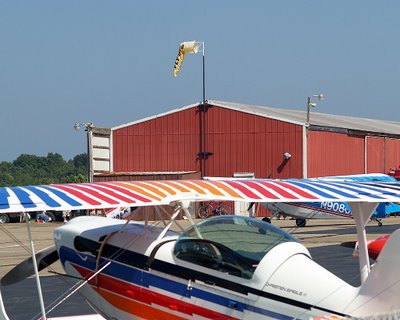

It never ceases to amaze me what people own. There were two privately own OH-58 Kiowas there. This is an artsy picture of one of their tail rotors:

The air show was fairly photogenic, primarily comprised of a T-6 flyby and a Citabria aerobatic routine. They also did the old stolen plane gag, but I have to say that the guy at the controls of that 172 really knew what he was doing, which admittedly did a great job of offsetting the hokeyness of the routine. Ah, how cynical I'm getting in my 25th year of flying!
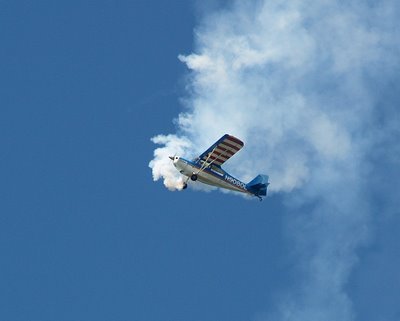

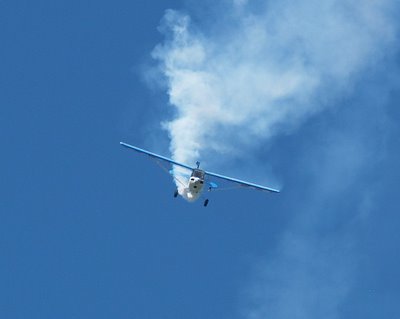



From all indications, my passenger had a great time rubbing elbows with the array of different airplanes types on display. It's always nice to have someone along on these trips, and I enjoy explaining what all of the pieces-parts of the airplane do. I've noticed that nearly everyone is fascinated by the control panel. Even people that routinely fly commercial airlines enjoy an introduction to all of the intimidating dials and moving parts that are normally hidden from them in flight, and are equally interested in how they all tie together in the operation of the plane. Of course, there's no easier way to demonstrate the interactions of the VSI, altimeter, gyros, etc. than being in the air. "What's the VSI do?" I simply pull back the stick and show the nearly immediate reaction of the VSI, and contrast it with the slower response in the altimeter. They're imparting two disparate pieces of information, of course, but yet they're tied together in the common goal of managing altitude. Sometimes I'll even toss the response of the airspeed indicator in as well, at no extra charge.
And of course, you're all on tenterhooks wondering how the landing back at Bolton went. Near greaser, just a wee bit of bounce. Not a bad ending to another fun RV day.
The desired early departure lying in ruin, I settled in to watch the METAR updates on the ADDS weather reporting web site. By 11:00 it looked like things were pretty clear to the north, but the southeast, being the desired direction of flight, was naturally still reporting low visibility. With the Parkersburg runway scheduled to close to arriving traffic at noon, I decided it was already too late to go. Rather than scrub the day, though, I thought we'd head up to Put-in-Bay instead. As we were pulling the plane out of the hangar, the guy that keeps his Yak (and a llama, for all I know...) in the hangar across from mine was preparing to depart to Vinton Co. airport for their annual air show. He had phoned down there and gotten a report of good VFR, so we decided we'd head there instead. When we were 10 miles out, I glanced at the XM weather on the Anywhere map and saw a red over white box down at Parkersburg, indicating that the ceilings were still IFR. That confirmed the decision to just give up on getting down there and land at Vinton.
The pattern at Vinton was pretty crowded, indicating that quite a few pilots had been biding their time waiting for weather conditions to improve and had all gotten into the air at around the same time. On left downwind we were #5 to land, with a yellow wing T-6 behind us as #6. There were a couple of high-wings entering on the left crosswind at the same time, so there were certainly a lot of planes to keep track of. Knowing the T-6 was close behind, I carried a few mph too many into the landing and was rewarded with the inevitable noisy bounce on landing, much to the amusement of the gathered on-lookers. Eh, que sera sera, as Doris used to say.
There was quite a crowd by the time all the planes got in, and there were also quite a few drive in spectators.

I was surprised at the number of motorcycles, many of them being big, shiny Harleys. I loved the clock on the fuel tank of one of the better examples:

One was to ensure that you'll always have company at a fly-in or airshow is to fly a Vans plane. At final tally I believe there were six in attendance:

One in particular seemed to garner a satisfying amount of attention:

There were two Christen Eagles there, and I still find them to be amongst the most attractive planes ever. I added one to my Fly Ohio collection:


It never ceases to amaze me what people own. There were two privately own OH-58 Kiowas there. This is an artsy picture of one of their tail rotors:

The air show was fairly photogenic, primarily comprised of a T-6 flyby and a Citabria aerobatic routine. They also did the old stolen plane gag, but I have to say that the guy at the controls of that 172 really knew what he was doing, which admittedly did a great job of offsetting the hokeyness of the routine. Ah, how cynical I'm getting in my 25th year of flying!






From all indications, my passenger had a great time rubbing elbows with the array of different airplanes types on display. It's always nice to have someone along on these trips, and I enjoy explaining what all of the pieces-parts of the airplane do. I've noticed that nearly everyone is fascinated by the control panel. Even people that routinely fly commercial airlines enjoy an introduction to all of the intimidating dials and moving parts that are normally hidden from them in flight, and are equally interested in how they all tie together in the operation of the plane. Of course, there's no easier way to demonstrate the interactions of the VSI, altimeter, gyros, etc. than being in the air. "What's the VSI do?" I simply pull back the stick and show the nearly immediate reaction of the VSI, and contrast it with the slower response in the altimeter. They're imparting two disparate pieces of information, of course, but yet they're tied together in the common goal of managing altitude. Sometimes I'll even toss the response of the airspeed indicator in as well, at no extra charge.
And of course, you're all on tenterhooks wondering how the landing back at Bolton went. Near greaser, just a wee bit of bounce. Not a bad ending to another fun RV day.
Wednesday, September 13, 2006
Photography contest
Grove City is having a crafts fest and parade this weekend, and one component of it is a photo contest. It's only a little thing with a nominal entry fee, so just for the fun of it I entered three of my favorite printed pictures:

(I wish I had cropped this one a little differently, but it was getting pretty grainy the tighter I cropped. I sent this one to Vans for consideration in their 2007 calendar and got "Ooh, nice shot, but do you have it in a higher resolution" in response. Should have bought the new camera sooner, I suppose.)

(This one looks a lot better at 20" x 30" and framed)
UPDATE: The picture above won an Honorable Mention which, if nothing else, is better than a Dishonorable Snubbing. I also saw a young girl voting for the picture below for People's Choice - between that one vote and the two received from my family, there's still a chance!

(With this one I'm blatantly shooting for the Peoples Choice prize - no one can look at this picture and not want to pet that dog!!)
I have a lot of newer ones that I like as well or better, but I've run out of space to hang them in the house so I've not gotten any of them printed and framed.
I wonder how these three will do. Judging is Friday night, so I'll know some time over the weekend. The entry process was amusing: the info sheet said "All entries MUST be framed, securely wired, and ready to hang with an S hook..." I took that to mean I needed to bring my own S hooks. I tried to stop at the local hardware store, but it was closed (AGAIN!! I keep trying to help these independents compete with Lowes, but they're never open when I try!) so I apologized to the lady handling the entries. She said they already had S hooks, but she "was impressed by my diligence." Heh!

(I wish I had cropped this one a little differently, but it was getting pretty grainy the tighter I cropped. I sent this one to Vans for consideration in their 2007 calendar and got "Ooh, nice shot, but do you have it in a higher resolution" in response. Should have bought the new camera sooner, I suppose.)

(This one looks a lot better at 20" x 30" and framed)
UPDATE: The picture above won an Honorable Mention which, if nothing else, is better than a Dishonorable Snubbing. I also saw a young girl voting for the picture below for People's Choice - between that one vote and the two received from my family, there's still a chance!

(With this one I'm blatantly shooting for the Peoples Choice prize - no one can look at this picture and not want to pet that dog!!)
I have a lot of newer ones that I like as well or better, but I've run out of space to hang them in the house so I've not gotten any of them printed and framed.
I wonder how these three will do. Judging is Friday night, so I'll know some time over the weekend. The entry process was amusing: the info sheet said "All entries MUST be framed, securely wired, and ready to hang with an S hook..." I took that to mean I needed to bring my own S hooks. I tried to stop at the local hardware store, but it was closed (AGAIN!! I keep trying to help these independents compete with Lowes, but they're never open when I try!) so I apologized to the lady handling the entries. She said they already had S hooks, but she "was impressed by my diligence." Heh!
Monday, September 11, 2006
Saturday, September 09, 2006
Newark-Heath Young Eagles Day
I don't know for sure what the occasion of the fly-in at Newark-Heath (KVTA) was, but it seemed to be the place to go today. At least six other RVs were going to be there, and is it's relatively nearby I could get there without making too big of a dent in my tanks of $3.98/gallon fuel. I'm hoping the gas prices follow the downward price trend of auto fuel soon! The weather was kind of clunky this morning and I spent an hour or so watching the METAR observations as the reported visibility slowly crept its way up to the 3 miles I needed. Once the air had cleared enough to ensure I'd be able to land there once I got there (which is obviously a desirable state of affairs), it was time to go. Even then it was reassuring to have the XM Wx unit cranked up so I could verify a white over white box over KVTA, indicating VFR ceilings and visibility.
The flight down and around the Columbus Class C was smooth and uneventful, and even the traffic in the pattern had died down a bit once I got there. There was very little wind to contend with, so I'm blaming the somewhat bouncy landing on not being as well practiced in near gross weight landings as I was a month ago. Being heavier than I'm used to requires quite a bit if adjustment in my RV: it runs out of "flare reserve" more quickly, and takes a bit more power in the pattern. In any event, they didn't roll the crash trucks so apparently no one noticed.
There were already plenty of planes there, and one of the first I saw was a Mooney Mite. The Mite was one of Al Mooney's earliest designs and it can readily be observed that it was the basis for all of his following designs, which are still being built this very day. I was interested in the Mite as a possible restoration project as I work on my A&P certificate because they are mildly exotic, small enough to not need a lot of room in the hangar, and pretty darn cool looking. Had I gone ahead and restored a Mite, this is what I hope it would have looked like when it was done:
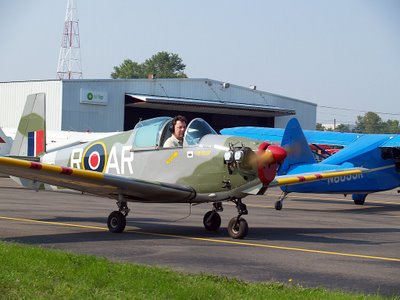
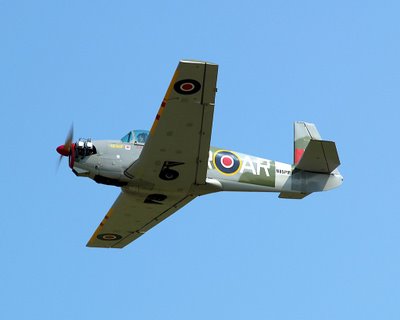
Another plane I've always liked is the Ercoupe. These were built in the mid to late 40's, back when the aircraft industry was convinced that the post WWII generation would be keen on owning airplanes. Many were built, and because of their low cost and inherent stable (safe) flight, there are many still available. I considered buying one a long time ago as a way to remove the renter's yoke and get into ownership, but a 50% share of a Mooney became available around that time, and as they say, the rest is history.
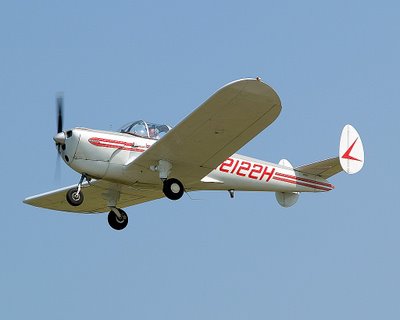
A gaggle of six RVs came in a bit later, and I made sure to get a shot of the line taxiing in. Some pilots call RVs "ramp fleas" or "ramp vermin" due to their ubiquity, but I prefer to compare them to women going to the restroom: they never go alone.
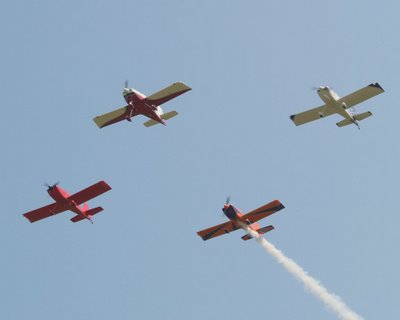

This was a very pristine Piper Cub that flew out early:

It's no Miata, but this Jag was very nice looking:
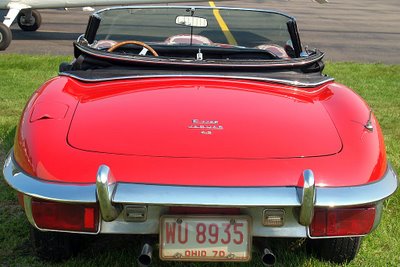

There were also a couple of T-6s there. The T-6 is a lot like the Stearman in that they are readily available for a reasonable cost, and I would love to own one, but the maintenance and operation costs scare me away.
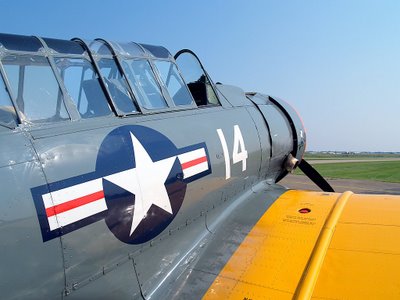
I caught the signature puff of smoke on engine start, but was a bit disappointed that I just missed a really cool burst of exhaust flame.

The flight back to Bolton was fun. I wanted to try getting some pix for Rick "Smoozer" Gray again, and with the low-level haze we had it was more photogenic to climb to 8,500' to get up into the clearer air. I interrupted my buddy Rick's airplane building again today and begged his assistance as in-flight phtographer in the hopes that having him shoot pictures while I concentrated on flying would result in a more successful shoot that last time. Smoozer was also taking pictures of my plane, so I'll post the results once I receive them. The descent back down through the valleys and canyons of the clouds was terrific fun, slaloming between the ever-building puffers like an Olympic downhill skier, except just a bit faster.
Update:
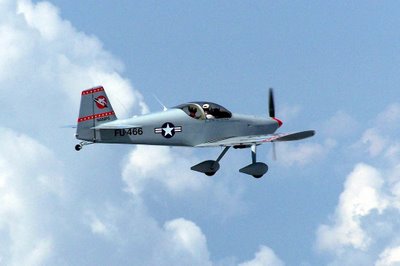
Photo by Rick Gray
The landing back at Bolton was ok with a nice, smooth touchdown, but there was a bit of a crosswind-induced swerve that I caught pretty quickly with a dose of corrective rudder.
Another great flying day, one hopefully that will only get better with a big win tonight against the Texas Longhorns. Go Bucks!!
The flight down and around the Columbus Class C was smooth and uneventful, and even the traffic in the pattern had died down a bit once I got there. There was very little wind to contend with, so I'm blaming the somewhat bouncy landing on not being as well practiced in near gross weight landings as I was a month ago. Being heavier than I'm used to requires quite a bit if adjustment in my RV: it runs out of "flare reserve" more quickly, and takes a bit more power in the pattern. In any event, they didn't roll the crash trucks so apparently no one noticed.
There were already plenty of planes there, and one of the first I saw was a Mooney Mite. The Mite was one of Al Mooney's earliest designs and it can readily be observed that it was the basis for all of his following designs, which are still being built this very day. I was interested in the Mite as a possible restoration project as I work on my A&P certificate because they are mildly exotic, small enough to not need a lot of room in the hangar, and pretty darn cool looking. Had I gone ahead and restored a Mite, this is what I hope it would have looked like when it was done:


Another plane I've always liked is the Ercoupe. These were built in the mid to late 40's, back when the aircraft industry was convinced that the post WWII generation would be keen on owning airplanes. Many were built, and because of their low cost and inherent stable (safe) flight, there are many still available. I considered buying one a long time ago as a way to remove the renter's yoke and get into ownership, but a 50% share of a Mooney became available around that time, and as they say, the rest is history.

A gaggle of six RVs came in a bit later, and I made sure to get a shot of the line taxiing in. Some pilots call RVs "ramp fleas" or "ramp vermin" due to their ubiquity, but I prefer to compare them to women going to the restroom: they never go alone.


This was a very pristine Piper Cub that flew out early:

It's no Miata, but this Jag was very nice looking:


There were also a couple of T-6s there. The T-6 is a lot like the Stearman in that they are readily available for a reasonable cost, and I would love to own one, but the maintenance and operation costs scare me away.

I caught the signature puff of smoke on engine start, but was a bit disappointed that I just missed a really cool burst of exhaust flame.

The flight back to Bolton was fun. I wanted to try getting some pix for Rick "Smoozer" Gray again, and with the low-level haze we had it was more photogenic to climb to 8,500' to get up into the clearer air. I interrupted my buddy Rick's airplane building again today and begged his assistance as in-flight phtographer in the hopes that having him shoot pictures while I concentrated on flying would result in a more successful shoot that last time. Smoozer was also taking pictures of my plane, so I'll post the results once I receive them. The descent back down through the valleys and canyons of the clouds was terrific fun, slaloming between the ever-building puffers like an Olympic downhill skier, except just a bit faster.
Update:

Photo by Rick Gray
The landing back at Bolton was ok with a nice, smooth touchdown, but there was a bit of a crosswind-induced swerve that I caught pretty quickly with a dose of corrective rudder.
Another great flying day, one hopefully that will only get better with a big win tonight against the Texas Longhorns. Go Bucks!!
Thursday, September 07, 2006
New review up on GamingNexus
Well, to be completely accurate, this one is a preview rather than a review. It's a subtle distinction in that there more than likely won't be a host of changes to the program between the 'Preview Build' and the 'Release Build,' but it's important to note nonetheless. (Is nonetheless one word or three??)
This one is a preview of the soon-to-be-released update to Microsoft Flight Simulator. I believe this will the the 10th version, so as you can imagine, it's a very polished piece of work. Frankly, to this day it boggles the mind to consider the incredible functionality you get for around $60. Technological miracles on a beer budget!
Here's the link, and pay particular attention to the italicized comments my editor always throws in:
http://www.gamingnexus.com/Default.aspx?Section=Article&I=1189
As a bonus for my loyal readers, here's a tidbit not reported in the review (because I forgot, to be honest):
One of the missions included in the new version is Red Bull Air Racing! I had really been looking forward to that, but I've found that I can't do it without crashing. That would probably be the case in real life, so it points to the accuracy of the sim, I suppose. That said, having watched Red Bull Air Racing on TV, it seems that the sim plane has a higher rolling intertia than the real planes. On TV, you see these guys throwing the plane into knife edge in less than a second, and pretty routinely stopping the roll at exactly 90 degrees before quickly snapping it back to level flight. In the sim, it is very hard to get the roll to stop that quickly, and I invariably over-roll to an attitude well past knife edge. Could be me, could be the sim, but in order to maintain some degree of self-esteem, I'm blaming the sim.
This one is a preview of the soon-to-be-released update to Microsoft Flight Simulator. I believe this will the the 10th version, so as you can imagine, it's a very polished piece of work. Frankly, to this day it boggles the mind to consider the incredible functionality you get for around $60. Technological miracles on a beer budget!
Here's the link, and pay particular attention to the italicized comments my editor always throws in:
http://www.gamingnexus.com/Default.aspx?Section=Article&I=1189
As a bonus for my loyal readers, here's a tidbit not reported in the review (because I forgot, to be honest):
One of the missions included in the new version is Red Bull Air Racing! I had really been looking forward to that, but I've found that I can't do it without crashing. That would probably be the case in real life, so it points to the accuracy of the sim, I suppose. That said, having watched Red Bull Air Racing on TV, it seems that the sim plane has a higher rolling intertia than the real planes. On TV, you see these guys throwing the plane into knife edge in less than a second, and pretty routinely stopping the roll at exactly 90 degrees before quickly snapping it back to level flight. In the sim, it is very hard to get the roll to stop that quickly, and I invariably over-roll to an attitude well past knife edge. Could be me, could be the sim, but in order to maintain some degree of self-esteem, I'm blaming the sim.
Monday, September 04, 2006
A quick out and back
The clouds finally lifted enough to get some flying in today. Not only that, the surface winds were just about nil, so for my first takeoff and landing in three weeks I wouldn't have to contend with a lot of wind.
I launched for Darke Co. at a little after 10am, and enjoyed a 175 knot cruise speed (or slightly more than 200mph for you landlubbers) at 2500 rpm. I had the AnywhereMap plugged in and working and although the weather was completely not-threatening, I saw the METAR blocks in action for the first time. These blocks are positioned over every weather reporting airport, and as long as they are all white I know that there is at least VFR ceilings and visibility. In theory I could simply head for an area of white squares when confronted by bad weather, but the blocks don't give any indication of wind speed so there's a bit more to it than just aiming for the white. To be 100% sure of the weather, I can click on a box with the stylus and it will bring up the full METAR text.
I had a good landing out at Darke Co. for a change, but I was using runway 9 rather than the dreaded 27 so that surely helped. There's just something about 27 that causes me fits on landing.
The landing back at Bolton was another good one, so perhaps a few weeks layoff acted as a tonic for the bouncy landing slump I was in before the unanticipated sojourn as a groundling. Still, I'd rather be flying than not, so I hope for some lasting nice weather so I can get that Cleveland trip in.
I launched for Darke Co. at a little after 10am, and enjoyed a 175 knot cruise speed (or slightly more than 200mph for you landlubbers) at 2500 rpm. I had the AnywhereMap plugged in and working and although the weather was completely not-threatening, I saw the METAR blocks in action for the first time. These blocks are positioned over every weather reporting airport, and as long as they are all white I know that there is at least VFR ceilings and visibility. In theory I could simply head for an area of white squares when confronted by bad weather, but the blocks don't give any indication of wind speed so there's a bit more to it than just aiming for the white. To be 100% sure of the weather, I can click on a box with the stylus and it will bring up the full METAR text.
I had a good landing out at Darke Co. for a change, but I was using runway 9 rather than the dreaded 27 so that surely helped. There's just something about 27 that causes me fits on landing.
The landing back at Bolton was another good one, so perhaps a few weeks layoff acted as a tonic for the bouncy landing slump I was in before the unanticipated sojourn as a groundling. Still, I'd rather be flying than not, so I hope for some lasting nice weather so I can get that Cleveland trip in.
The King of Impulse Buying
I didn't do my oft-deserved (but occasionally not) reputation as the King of Impulse Buyers (DAMN YOU Sams Club, for giving me that reputation!) any favors last week. You see, I had planned on making that Cleveland trip again, but the weather simply wasn't good enough up by the lake. Having already planned the day away from work and gotten some time on my Dad's busy horse racing schedule, I decided that we would instead make a trip to some of the local car lots. He's in the market for a nice, pre-owned BMW, and Columbus is a much better hunting ground for a car like that than the truck-centric semi-rural area he normally shops in.
Long story short, he didn't find the car he was looking for, but I did. As I was wandering around the massive CarMax (a tremendous place to buy a used car! It was the easiest used car buying experience I've ever had - highly recommended!!) lot, I happened across a car that I've been looking for off and on for a couple of months: an under $10k Miata. While I didn't actually write a check for it on the spot, the 2 hour delay in running home to get the checkbook doesn't really change the fact that there was not a lot of time spent between seeing the car and owning the car!
So, without further ado, here's my new (to me) drive-to-work-except-when-theres-a-forecast-for-snow car:
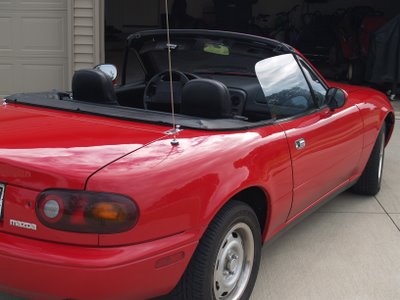
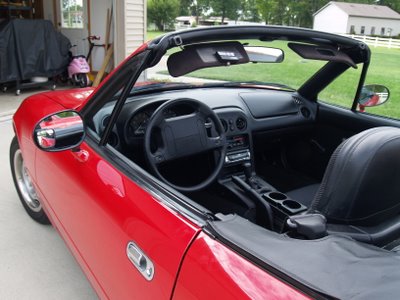
This is truly the RV-6 of cars. It's small, handles very well, doesn't have huge reserves of power, but you can't drive it without smiling! It's tiny, though - I could easily simply step over the doors to get in, rather than opening them and climbing down into the seats. It was a real eye-opener when I first pulled into the garage and look up at my lawn mower!
It's a base model 1996 with 72k miles, new paint, new top, new Potenza tires, and a new Jensen radio. No reason (in my mind, anyway) that it has to remain a complete base model, though. I think a few bling items would go nicely, like these new wheels and a new steering wheel:
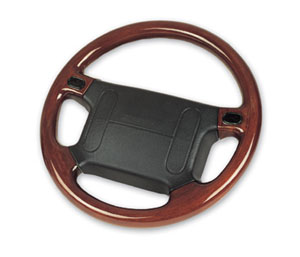

I think I might reupholster the seats in leather too, since the old cloth seats are pretty worn and the headrest speakers need to be replaced anyway. I think the gray in this example would go nicely with a scarlet color car here in Buckeye land:
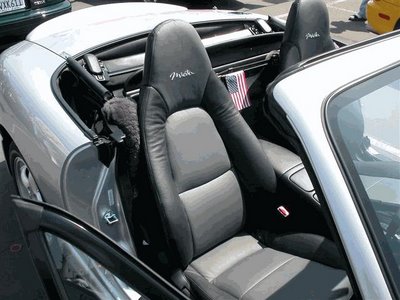
I wonder how Harbor Freight is for metric car tools....
Long story short, he didn't find the car he was looking for, but I did. As I was wandering around the massive CarMax (a tremendous place to buy a used car! It was the easiest used car buying experience I've ever had - highly recommended!!) lot, I happened across a car that I've been looking for off and on for a couple of months: an under $10k Miata. While I didn't actually write a check for it on the spot, the 2 hour delay in running home to get the checkbook doesn't really change the fact that there was not a lot of time spent between seeing the car and owning the car!
So, without further ado, here's my new (to me) drive-to-work-except-when-theres-a-forecast-for-snow car:


This is truly the RV-6 of cars. It's small, handles very well, doesn't have huge reserves of power, but you can't drive it without smiling! It's tiny, though - I could easily simply step over the doors to get in, rather than opening them and climbing down into the seats. It was a real eye-opener when I first pulled into the garage and look up at my lawn mower!
It's a base model 1996 with 72k miles, new paint, new top, new Potenza tires, and a new Jensen radio. No reason (in my mind, anyway) that it has to remain a complete base model, though. I think a few bling items would go nicely, like these new wheels and a new steering wheel:


I think I might reupholster the seats in leather too, since the old cloth seats are pretty worn and the headrest speakers need to be replaced anyway. I think the gray in this example would go nicely with a scarlet color car here in Buckeye land:

I wonder how Harbor Freight is for metric car tools....
The end of the hiatus at last??
Looking out the window this morning, it looks like we may finally have some decent flying weather today! It seems like it has been weeks since we've seen the sun, or at least had a cloud layer high enough to allow for comfortable cross-country flight. The enforced layoff has been way too long! Co-pilot Egg and I even went so far as to go a radio control airplane "fly-in" here in Grove City a couple of weeks ago.
Radio control (RC) was my earliest entry into the world of aviation, if you don't count the umpteen control line planes I went through in a never successful chase after the elusive loop-the-loop, as we called it back in the last century. I was the neighborhood specialist at the figure 9, though! Unfortunately, as the figure 9 was defined as a loop that ended in a nose first impact with the unforgiving ground, you could usually only do those once per airplane. I clearly remember the seemingly interminable Sunday sermons at church, daydreaming about what it would be like to be able to control the model airplane without the strings attached. Oddly, I don't think that I had ever actually seen an RC airplane fly at that time.
I've pretty much always had some kind of paying job or another, so I was able to start bankrolling my aviation passion at the relatively young age of 15. My first RC plane was a Sig Kadet. Back then, there were no ARF (Almost Ready to Fly) kits - you built the things by cutting the parts out of sheet balsa. My dad made the first one for me, but the next dozen I built myself. Although I avoided the ignominious fate of ever having cut out two of the same fuselage sides (I guess that was pretty common), I wasn't a terrific builder by any means. That's why I was so impressed by the scale modellers that could build a plane that was indistinguishable from the real thing without something to give you perspective.
The Fly-in that Egg and I went to was very impressive along those lines, but even more interesting was the new advances in model airplane engines: these planes were powered by true jets and turboprop engines! Back in my day, we had the 2 cycle glow engines. If a builder wanted a jet, he put a fan on the engine and stuck it in a duct. They screamed like banshees, but they weren't real jets. These days, for a couple of thousand dollars you can buy an actual jet engine. They sound like jets, they smell like jets, and by golly, they fly like jets!
Here are a few pictures I took, and I promise you I'm not having you on - these are actually model airplanes(!!):




Amazing!!
Radio control (RC) was my earliest entry into the world of aviation, if you don't count the umpteen control line planes I went through in a never successful chase after the elusive loop-the-loop, as we called it back in the last century. I was the neighborhood specialist at the figure 9, though! Unfortunately, as the figure 9 was defined as a loop that ended in a nose first impact with the unforgiving ground, you could usually only do those once per airplane. I clearly remember the seemingly interminable Sunday sermons at church, daydreaming about what it would be like to be able to control the model airplane without the strings attached. Oddly, I don't think that I had ever actually seen an RC airplane fly at that time.
I've pretty much always had some kind of paying job or another, so I was able to start bankrolling my aviation passion at the relatively young age of 15. My first RC plane was a Sig Kadet. Back then, there were no ARF (Almost Ready to Fly) kits - you built the things by cutting the parts out of sheet balsa. My dad made the first one for me, but the next dozen I built myself. Although I avoided the ignominious fate of ever having cut out two of the same fuselage sides (I guess that was pretty common), I wasn't a terrific builder by any means. That's why I was so impressed by the scale modellers that could build a plane that was indistinguishable from the real thing without something to give you perspective.
The Fly-in that Egg and I went to was very impressive along those lines, but even more interesting was the new advances in model airplane engines: these planes were powered by true jets and turboprop engines! Back in my day, we had the 2 cycle glow engines. If a builder wanted a jet, he put a fan on the engine and stuck it in a duct. They screamed like banshees, but they weren't real jets. These days, for a couple of thousand dollars you can buy an actual jet engine. They sound like jets, they smell like jets, and by golly, they fly like jets!
Here are a few pictures I took, and I promise you I'm not having you on - these are actually model airplanes(!!):




Amazing!!
Subscribe to:
Posts (Atom)
